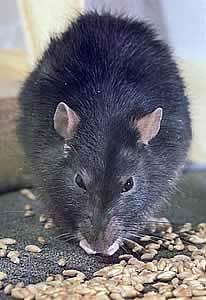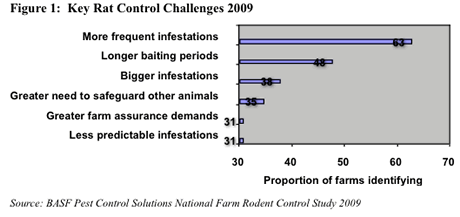 |
|||||||||
|
|||||||||||||||||||
|
|
Latest Study Pinpoints Serious Farm Rodent Problems Large numbers of farms across the country are continuing to suffer serious rat and mouse problems reveals the latest annual rodent control study conducted by rural hygiene leaders, BASF Pest Control Solutions. And this despite more frequent rodenticide use and generally improved baiting practice.
The 2009 study involved over 90 separate holdings spanning a broad range of enterprises spread over nearly 32,000 acres. The overwhelming majority of farms experienced both rat and mouse problems at some stage in the year, with rat infestations rated considerably more serious by most. Every farm carried out some rodenticide baiting in the year ending last October, with over 90% undertaking three or more cycles against the 80%-plus doing so in 2008. Unsurprisingly perhaps, the winter months saw the greatest rodenticide use, with over 70% of farms baiting in each month from September through to February. Baiting fell off slightly in March and declined steadily from April to June before picking up again from July. Even so, fully 15% of farms used a rodenticide in June. “Every farm can identify at least one way in which they are finding rodent control more challenging these days,” reveals local BASF Pest Control Solutions specialist, Ken Black. “Just like 2008, bigger and more frequent infestations and longer baiting periods are considered the three greatest challenges. A greater need to safeguard other animals, greater farm assurance demands and less predictable infestations are also identified as key control challenges by many (Figure 1).
“This underlines the extent to which rodent control pressures are bearing down on farms from all sides these days. Rat and mouse infestations are becoming more problematic and less predictable. At the same time, there is a growing need to demonstrate good control for farm assurance purposes. And baiting has to be increasingly secure to protect non-target species which can seriously limit its effectiveness in some cases; especially so with less and less time available on most units. “Today’s pressures really put the onus on the best possible rodent control practice at all times,” he insists. Under these circumstances, Ken Black finds the high degree of environmental responsibility indicated by the fact that nearly three quarters of farms now place all their rodent bait in secure containers particularly encouraging. He also commends farmers for their continued improvement in most key control practices over the past three years. However, he identifies a number of causes for current concern in this context. “Our study shows only 4% of farms are currently employing all six of the most important elements of best rodent control practice, for instance,” he points out. “Half are using two or fewer elements and 15% none whatsoever. So most farms clearly have considerable room for improvement in rising to the increasing control challenge. “With difenacoum the rodenditicide of choice on seven in every 10 units, three quarters opting for wheat-based baits and fully half utilising our high-tech, Fortec-enhanced Neosorexa Gold for more rapid and reliable uptake and control, farmers are clearly appreciating the value of the latest rodenticide technology in their control efforts. “But they would do well to concentrate on improving the accuracy of their bait point siting, the number of bait points they use, the frequency with which they top them up and the extent to which they rodent proof alternative food sources. “While many farmers are currently baiting widely in several important locations around the farmstead, most could undoubtedly profit from extending their rat baiting beyond the immediate surroundings of stock buildings, grain and feed stores and hay and straw stacks too. Rough ground around silage clamps and waste storage areas tend to be well used for burrows, yet the majority of farms don’t target them for baiting. “Equally, in tackling rats it really helps to permanently site empty bait containers in key locations to overcome their natural wariness of new things – something less than a third of farmers currently do.”
|
||||||||||||||||||

|
|
||||||||||||||||||
| home | agri-services | pedigree
pen | news | dairy | beef | machinery property | organisations | site map |
|||||||||||||||||||


